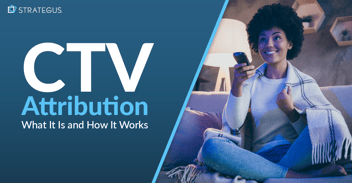- Home
- Strategus Blog
- E-Commerce Advertising: Choosing Between Omnichannel or Multichannel
E-Commerce Advertising: Choosing Between Omnichannel or Multichannel
 Andy Dixon
Andy Dixon
6 minutes read

This Blog is part of our larger Guide to Understanding Omnichannel Marketing, click here to learn more
You’re likely looking to improve your digital marketing efforts and boost e-commerce sales, and you’re not the only one. Given the state of the economy and recent events, businesses are discovering the advantages of taking their business to the internet, both exclusively and additionally.
Either way, one goal remains the same — finding and using the best tactics to target the correct audience. The solution is the same: reach your audience on multiple channels through consistent messaging.
Zoom Info reports that 51% of companies today use at least eight channels to interact with customers, and 95% of marketers say they know how important it is to use multiple channels for targeting their marketing efforts.
Omnichannel vs. Multichannel E-Commerce Advertising

Omnichannel vs. Multichannel e-commerce advertising… Let’s discuss this. Both multichannel and omnichannel e-commerce advertising methods target audiences through more than one channel, which is why they are often wrongly considered synonymous with one another. Instead, there are major components at play that separate the two strategies from each other and make one more effective than the other by a long shot.
Before you make your choice between the two similar but significantly different advertising methods, there’s information you need to be familiar with first.
E-COMMERCE SPENDING IS ON THE RISE
E-commerce spending was already climbing in popularity, with Statista reporting that in 2019 alone, there were an estimated 1.92 billion people purchasing goods or services online. In 2020, the impact of the pandemic on online shopping caused consumers to spend $861.12 billion online with U.S. merchants — up 44% year over year, according to Digital Commerce 360.
This past year global retail e-commerce sales increase by 16.8% to $4.921 trillion, from 4.213 trillion in 2020.
Moving forward, it’s becoming more and more important that businesses not only adapt to advertising and communicating on multiple channels, but they do so in a manner that resonates with consumers. This is when multichannel efforts start to get kicked to the curb for being outdated, and here’s why that is:
People prefer to manually work their way through the buyer’s journey rather than be sold to, so modern advertising must toe that line carefully. Omnichannel marketing tactics are one solution because it makes the campaign seem more personal and less “salesy” since the messaging is consistent, making the potential buyer feel more valued.
By coordinating consistent efforts, teams can be sure that the consumer’s experience with your brand at all touchpoints is positive, memorable, and valued as more than ‘just a sale.’ The major difference? Prioritizing your customers over your sales.
THE OLD WAY: MULTICHANNEL E-COMMERCE
Multichannel e-commerce is a method that essentially spams the buyer with different, unrelated advertisements across multiple channels. This feels more like a direct sales pitch and is less effective at driving e-commerce success. This is not to say multichannel efforts are entirely ineffective. It just means multichannel efforts without more focus on your target audience are less effective.
How It Works
Multichannel marketing refers to the strategy of reaching a wider audience through multiple channels, upgrading the once-popular single-channel marketing methods that existed prior.
The idea was to move away from putting all efforts into one channel and expanding it into multiple like in-store, web, social, and mobile. From there, each channel works individually to reach consumers and encourage them to take action and make a sale. Each effort, message, and experience is different from the others, resulting in inconsistent and questionable encounters with consumers.
The Problem
It’s simple — consumers want consistency, so they can rely on your brand to give them the same experience no matter where and when they make contact. More specifically, 69% of consumers expect a consistent cross-channel customer experience. The multichannel concept is good in theory, but without consistency, it simply cannot maximize your advertising efforts.
THE NEW WAY: OMNICHANNEL E-COMMERCE

On the other hand, omnichannel e-commerce delivers a cohesive message to the buyer across related channels. While still “salesy” in nature (because you can never really get away from it when encouraging sales), these strategies are more likely to result in e-commerce success due to the consistent message and overall relation to the buyer. Studies reported by UC today suggest that nine out of 10 consumers want an omnichannel experience with seamless service between communication methods.
How It Works
Omnichannel marketing takes the foundation of multichannel marketing and expands it into a more evolved solution to reaching and connecting with consumers. The basis is the same — use multiple channels.
However, there are three additional components to know when discussing omnichannel vs. multichannel:
- The main goal — While multichannel aims to cast a wide net and hope for the best (meaning as many sales as possible), omnichannel gives special attention to the customer and their experience with your brand on all channels.
- Personalization — Omnichannel coordinates efforts to ensure each experience is personalized to the consumer and where they are in the buyer’s journey, while multichannel just wants to get the message out.
- Consistency — Omnichannel integrates marketing efforts to spread the same message to the right people. Multichannel works separately, so consistency is often lacking.
The Results
On average, companies with strong omnichannel customer engagement retain 89% of their customers, compared to 33% for companies with weak omnichannel customer engagement or no omnichannel strategy.
Making the Switch to Omnichannel

Chances are your single-channel or multichannel efforts aren’t working. Or at least, not working well enough. Multichannel is superior to single-channel, but omnichannel takes the best qualities of multichannel and maximizes them. The question is no longer whether to make the switch but when. And honestly, the sooner, the better.
When you’re ready to drop outdated, unconnected multichannel campaigns to learn more about how omnichannel campaigns can lead to an increase in e-commerce traffic and sales, contact our team at Strategus. Our Encore Omnichannel technology and techniques are the new and improved solution to your marketing problems.


Andy Dixon is a seasoned Content Writing Specialist at Strategus, renowned for his expertise in creating engaging and impactful digital content. With over a decade of experience in content creation, Andy has honed his skills in a variety of niches, ranging from technology and marketing to education.
Strategus is a managed services connected TV(CTV) advertising agency with over 60,000+ campaigns delivered. Find out how our experts can extend your team and drive the result that matter most.
Talk to an Expert
Seeking a Custom CTV Strategy That Delivers?
What to read next

Third-Party Data Targeting for CTV: Benefits & Tactics
Third-party data. It’s a term that’s thrown around, and yet few take the time to detail its pros and cons — much less strategies for using...
7 minutes read

First-Party Data Targeting: Benefits and Tactics for CTV Advertising
First-party data is the information that companies collect directly from their customers rather than through intermediaries. Advertisers use this...
10 minutes read

Foot-Traffic Attribution: Tying Ad Impressions to In-Store Visits
The marketing funnel has changed. Today’s shoppers often begin researching products from the comfort of their homes and don’t set foot into a store...
8 minutes read

CTV Attribution: What It Is and How It Works
Connected TV (CTV) viewing is on the rise — and that’s good news for marketers. Not only can CTV ads be precisely targeted to individual households,...
9 minutes read















